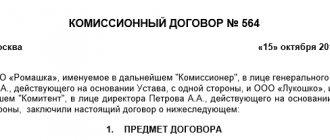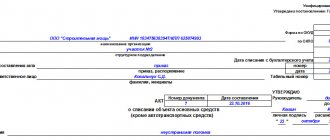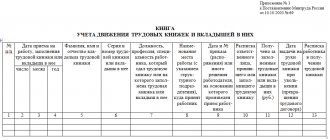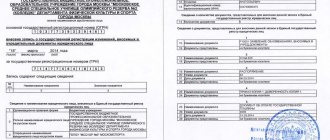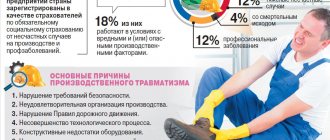Labor Dispute Commission - what is it and what is it for?
The committee’s activities include both working with management, preventing unlawful actions or inactions of the manager, and working with employees, eliminating their poor quality work or pointing out deviations from the requirements of the labor code and contract.
The Labor Dispute Commission at an enterprise is a special body created to resolve various labor conflicts.
In fact, the commission is an element of social regulation of labor relations and the protection of citizens from negligent employers.
The Labor Code does not stipulate the chronological scope of action of this body, and therefore the commission can be convened either once to resolve a conflict, or regularly to resolve several disputes.
The creation of a commission is initiated:
- employees of the enterprise,
- the desire of management.
In the first case, this will be justified by the desire of employees to receive protection from unlawful actions of the manager.
In the second case, it is the desire of superiors to have leverage over unscrupulous subordinates. In some situations, employees are reluctant to create a labor commission. This is due to a number of reasons:
- Fear of the employer, reluctance to lose your job.
- The opinion that the organization does not provide reliable protection.
- Fear of ruining relationships with colleagues.
Reluctance to create a commission on the part of employees cannot be the reason for fines or any other penalties.
At the same time, a manager’s obstruction of the creation of a workers’ committee is considered a violation; such actions by management can be appealed to higher authorities.
Stages of formation
The process of creating a labor dispute commission takes several stages. In order to launch it, the employee must contact his manager in writing, observing the requirements of Article 384 of the Labor Code (LC RF).
After this, the composition of the commission is formed. Candidates for the positions of its members can be either supported by the organization’s employees or refuted. Membership in the commission is voluntary. It is impossible to force an employee to perform this social function against his will.
Next, the creation of a new governing body is documented. For this purpose, an order is created to create a labor dispute commission. It is carried out on a special form, and in its absence - on an A4 sheet according to the approved sample.
The required details of the order are:
- state emblem (for government agencies) or company emblem;
- serial number of registration in the journal;
- reason for creation;
- document creation date;
- date of signature by the head of the enterprise;
- the exact name of the company.
The Labor Dispute Commission (LCC) of the Russian Federation is regulated on all issues. If the activity of this body at the enterprise has caused a conflict situation, it is possible to liquidate the commission only upon applications of the persons who initiated its creation.
The composition of the commission is usually 15 people, but it can be more. All of them are included through collective voting.
The Commission must elect from among its members responsible persons with certain functions:
- Chairman.
- Deputy.
- Secretary.
- Employer representatives.
As a rule, these positions are filled by persons with a legal education or at least one year of work experience in this field.
The selection of the chairman is also carried out by voting. It is he who regulates all processes of the commission. Without his participation, labor disputes cannot be resolved. With his signature, he confirms the authenticity and reliability of the results of the meeting.
The deputy performs the functions of the chairman during his absence - he supervises the work, takes part in the process of considering the dispute.
The secretary plays an equally important role in the organization - the responsibility for accepting and registering documents falls on his shoulders. He keeps minutes of the meeting and all documentation of the commission.
We recommend you study! Follow the link:
Labor Code of the Russian Federation on the rules for forming a commission to investigate the fact of injury
The employer appoints a number of representatives of its interests on the commission. These positions are not elective; the manager appoints such people at his own discretion. They will be present at every meeting with the right to vote.
How to contact the labor dispute commission
The commission does not meet every day.
Its members, when free from such optional duties, perform tasks in accordance with their contracts. Therefore, only writing an application to the CCC activates the activities of this body. The document may be handwritten or printed. But in any case, it must comply with the state model. Its structure has a canonical form.
Mandatory components of the application include:
- document header;
- statement of the essence of the problem;
- attachment of documents confirming the illegality of the actions being appealed;
- signature and date.
The header of the application must contain information about the applicant (full name, passport details) and his contacts (address, telephone). After this, you must indicate the word “Application” in the middle of the sheet.
Next, in the paragraph, you need to talk about the reasons for the appeal (how and when the violations of the employment contract occurred, who took part in this procedure). You need to present it consistently, without being distracted by unimportant details. Another necessary condition for an application of this type is an indication of the requirements - what the applicant wants to receive as a result of the application and proceedings.
There are rules for designing applications. If there are several such documents, they can be listed in the application and also numbered.
The document must be drawn up in two copies. One of them is given to the commission, the second remains in the hands of the applicant. The second copy must be marked with acceptance for consideration. Otherwise, there is a high risk of losing the document and leaving the problem without consideration.
The Labor Dispute Commission and the head of the organization must familiarize themselves with the submitted application. This mandatory procedure must be followed.
For a positive outcome of the commission’s decision, the affected part is required to provide evidence.
Evidence includes:
- audio and video recordings;
- electronic correspondence;
- photocopy of the employment contract;
- photographs, maps, plans;
- photocopies of internal regulations (orders, acts).
If video and audio materials are used as evidence, the oral speech contained in the recordings must also be documented in writing.
Electronic correspondence is evidence only if it was notarized and carried out within the framework of corporate mail.
All arguments presented must correspond to the topic of the application and be direct evidence of unlawful activity or inaction of the official.
Consideration of individual labor disputes in the CCC: procedure
Before contacting the CCC, the employee must try to resolve disagreements with the employer on his own (Part 2 of Article 385 of the Labor Code of the Russian Federation). If it was not possible to resolve the conflict peacefully, he has the right to submit an application to the commission with a request to resolve the dispute. He has three months to do this - this is the deadline for applying to the CTS. They are counted from the day when the applicant learned (should have known) about the violation of his labor rights (Article 386 of the Labor Code of the Russian Federation).
Having accepted the application, the commission must resolve the dispute within 10 days. If the employee does not submit a request to consider the dispute in his absence, he is obliged to either appear in person at the meeting or send his representative. The CTS has the right to request the necessary documents from the employer and hear invited witnesses. The decision is made by a simple majority of votes counted after a secret ballot. For it to be valid, at least 50% of representatives from each party - employees and employer - must be present at the meeting of the CCC (Article 387 of the Labor Code of the Russian Federation).
Both the employee and the employer have the right to appeal the decision of the CCC. They can do this by going to court. There is a 10-day period for appealing - from the date of receipt of a copy of the commission’s decision (three days are given for its production and delivery).
If none of the parties to the conflict appealed to the court, the decision of the CCC is subject to execution within three days (after the expiration of the 10-day period for appeal). If it is not fulfilled, the employee is given a special certificate equated to a writ of execution. And then the decision is subject to forced execution, with the involvement of a bailiff (Article 389 of the Labor Code of the Russian Federation).
Authority and Competence
The Labor Dispute Commission has the right to resolve many conflict situations, but also has taboos on certain issues.
The jurisdiction of the commission does not include:
- topics of pension assignment;
- conflicts about seniority;
- questions about the payment of travel and vacation pay;
- disputes about the amount of the bet;
- questions about production standards.
These types of disputes are resolved through the judiciary.
You can contact the labor dispute committee within 30 calendar days from the date of the violation.
In turn, members of the commission undertake to review the application and materials thereto within 10 working days. The countdown starts from the beginning of the document submission date. In the event that the last day intended for consideration falls on a holiday or weekend, the deadlines are extended until the first working day.
The application cannot be accepted for consideration by any member of the commission - this must only be an authorized person with the right to register documents.
We recommend you study! Follow the link:
Methods and forms of resolving labor disputes
Competence, composition, powers
Composition of the commission:
- Representatives of the employer, who are delegated on the basis of an order from management.
- Representatives of the labor collective representing the interests of the employee with whom the dispute has arisen.
The structure of the labor dispute commission consists of the following:
- chairman;
- vice-chairman;
- secretary.
It is believed that the minimum number of members of such an assembly cannot be less than 15 people.
The most important function is the consideration of individual disputes that arise within one organization. The powers do not “extend” beyond the boundaries of the enterprise.
A notable feature of the rights is that the commission is an independent unit; it is not subordinate to management. You should also know that disputes can be resolved through the involvement of these representatives, both between management and current employees, and those employees who no longer work in this institution.
Individuals who applied for any open vacancy and were not accepted due to objective reasons may also apply to the authority upon application. There is no reason not to accept the complaint for consideration.
Competence and authority to resolve disputes may relate to the following issues:
- Correctness, correctness, rationality of payroll calculation.
- Application of disciplinary measures to the employee, including recovery from wages.
- Working conditions, their proper provision.
- Hiring and dismissal from a position, demotion according to the staffing table, etc.
- Any other problematic issues that were not resolved as a result of an agreement between the entities.
But the competence of this council cannot include such subject areas as:
- reinstatement after demotion;
- reinstatement at work in any position after dismissal;
- any kind of compensation payments related to dismissal;
- withholding funds based on absenteeism.
All of the listed subject areas are already within the competence of the court and should be considered exclusively in court, according to the decision of which a legitimate verdict will be made: to reinstate the person or not.
Competence and powers are also defined by the Labor Code of the Russian Federation, Article 385.
Procedure for consideration
The consideration of the conflict occurs in several stages. Each of them is regulated by relevant legislation.
Review periods:
- writing an application;
- collection of necessary documentation;
- collection of evidence;
- paperwork;
- provision of materials to the commission;
- waiting for results.
Participants in the conflict have the right to introduce additional evidence, refute the opponent, ask the commission members to provide time to collect arguments, or attract independent specialists or create an additional inspection.
In addition, each of the parties to the dispute may ask to temporarily replace a member of the commission.
Reasons for disqualifying a member of the labor commission:
- personal hostility towards one of the parties to the dispute;
- friendly relations in relation to the participant in the labor conflict;
- incompetence in this matter;
- interest in a certain outcome of the case.
Commission decision
The procedure for making a decision by the commission provides for the adoption of the result within 5 days after the meeting.
The process takes place in the form of voting, and the result is determined by a majority vote.
The commission undertakes to provide its decision in writing to both parties to the labor conflict.
Due to this, the decision comes into effect within a month. Exceptions are also possible if the case concerned the payment of funds and there is a need to make compensation as soon as possible.
Appealing the decision
If the commission performs its work poorly or does not comply with the chronological framework of the consideration, the employee has the right to transfer the consideration of the individual conflict situation to a higher level in court.
It should be taken into account that the procedure for consideration by the labor committee is not a mandatory stage in resolving the dispute - it can be successfully skipped.
There is also a procedure in which a labor conflict can be considered in two instances simultaneously - in court and in a committee.
If an employee does not agree with the committee’s decision, he can appeal it in court within 10 days.
In addition to the committee’s decision, the employee will also need to develop an argumentative basis. Particular attention must be paid to photocopies of documents - they must be certified and their authenticity proven. If it is impossible to certify photocopies, you must provide the originals.
Who initiates the creation
The initiative to create can come from:
- Employee.
- Employer.
- A body that protects the interests of the employee (for example, a trade union).
- By agreement of both parties.
An equal number of representatives from both sides is determined.
To do this, a written proposal to create a commission is sent to employees and the head of the organization. Within 10 days, the parties send their elected representatives.
Delegates from the enterprise administration are usually appointed by the manager. Members of the working group are elected either at a general meeting of employees, or the body for protecting the interests of employees immediately delegates a team of employees, and it is approved at a general conference of employees. If not approved, the team members are reviewed.
There are two sides as opponents in labor disputes. If everything is clear with the employer, then the other party may not only be the person currently working at the enterprise.
The following also have the right to convene a commission:
- Former employees. Can defend issues that arise while working at the enterprise.
- Employee candidates. If a person wanted to get a job at a company, but was refused for a number of reasons. When the reasons seem unreasonable, he may ask for a meeting of the CCC.
Protocol and seal of the CCC
The minutes describe the progress of the meeting. It should contain information about the participants in the process, indicating the agenda and stages of consideration of the case.
The minutes also record all speeches and statements during discussions. The final part contains information about the results and the decision made. This information must be certified by the signature of the chairman and secretary. The date of the meeting must be indicated.
To record the legality and reliability of information, a seal is used along with the signature of the chairman.
It can be of two types:
- standard company seal;
- created specifically for the commission.
The second type of seal contains the name of the organization, its details, as well as the CTS marking.
HOW TO CREATE CTS
Stage 1. Take the initiative
The team or management of the enterprise must take the initiative to create a CTS.
Important nuances of this stage:
• the initiative must be formalized in the form of a written proposal;
• an individual employee does not have the right to express such initiative.
CTS cannot be created at the request/suggestion of one or more employees[1];
• the employer's refusal to create a CTS may be regarded as avoidance of participation in negotiations on the creation of a CTS;
• the consequences of further events largely depend on who exactly took the initiative in creating the CTS (Diagram 1).
Stage 2. Determine the composition of the CTS
Having reached agreement on the creation of the CCC, the employee representatives and the employer’s management begin to determine the quantitative and named composition of the CCC, as well as to resolve the organizational and technical issues of creating this body (where the CCC will meet, its operating hours, the procedure for providing furniture and stationery, etc. .).
The procedure for the formation of a CTS is regulated by Art. 384 Labor Code of the Russian Federation. But the law does not contain any criteria or time frame for the activities of the CCC, therefore, when creating a CCC, it is necessary to determine the urgency or indefiniteness of its existence.
When determining the composition of the CTS, the following must be taken into account:
• requirements for the quantitative composition of the CTS are not regulated by law. But from the requirements below it follows that the quantity must be even;
• the CCC must have an equal number of members on behalf of employees and on behalf of the employer;
• The CCC elects a chairman, deputy chairman and secretary of the commission from among its members.
Stage 3. Develop Regulations on CTS
The regulations on the CCC are developed and adopted by the already elected composition of the commission. In this case, the clauses of the Regulations on the CTS must comply with the requirements established by Art. 387–390 Labor Code of the Russian Federation.
The Regulations on the CTS must provide for the following points:
• operating procedure of the CTS, its operating mode;
• procedure for convening a meeting of the CCC;
• the validity of meetings of the CCC in the absence of any of its members;
• development of regulations on the chairman and secretary of the CCC;
• quorum;
• procedure for liquidation of CTS, etc.
KTS certificate
The CCC certificate is a document that allows you to appeal the commission’s decision or hold accountable the party that refused to comply with its decision. This procedure is carried out in court. It remains relevant for three months.
Thus, the labor process does not always go smoothly. From time to time, disruptions occur in work or a dispute arises between team members. In some cases, the dispute can be resolved by the participants themselves, in others, such a procedure turns out to be impossible.
In such cases, the labor dispute commission gets involved in the work. With the help of this organization, you can resolve conflict issues, as well as come to the truth in a labor dispute.
Labor commission
The interpretation of the norms of the Labor Code of the Russian Federation by employees and employers may differ. This is how a labor dispute arises. The creation of a labor commission (labor dispute commission, CLC) allows you to consider and solve such problems within the organization, without resorting to the help of third parties. The only exceptions are cases considered, according to the law, in court.
A CTS can be created at the initiative of employees, a trade union organization, an employer, or by their mutual decision (Article 384, paragraph 1 of the Labor Code of the Russian Federation). The legislator has established a 10-day period for its creation from the moment such a proposal is received.
The competence of the commission includes the following issues:
- timely payment of wages;
- wages are not paid in full, excluding overtime, weekends and holidays;
- refusal to reimburse travel expenses;
- non-compliance with the terms of the employment contract, unilateral changes in these conditions;
- relating to financial liability;
- regulating the vacation schedule, providing time off;
- imposing a disciplinary sanction if the employee does not agree with it, etc.
The competence of the commission does not include disputes regarding dismissal, reinstatement, transfer to a lower position based on certification results, compensation payments from the employer after illegal dismissal or transfer, refusal to hire, violation of the law on personal data, or claims for compensation for moral damage. They are decided only by the court.
Any employee who believes that his rights have been violated can contact the labor commission within 3 months after the violation is discovered (Article 386 of the Labor Code of the Russian Federation). The commission has 10 days to consider the issue (Article 387 of the Labor Code of the Russian Federation).
Creating a commission is an optional procedure. The legislation does not in any way regulate the timing of its creation or the number of commission members. Article 384 of the Labor Code of the Russian Federation speaks only of an equal number of representatives from employees and employers and the need to elect a chairman and secretary from among them. Employees elect their representatives at a general meeting, and the employer appoints them by order.
A labor commission can be created to resolve a specific dispute or work permanently, created for the organization as a whole or in each individual structural unit. The labor commission must have its own seal. The administration is responsible for organizing the work of the commission.
If the commission’s decision is not executed, the employee is given its certificate (writ of execution). According to this document, the FSSP can enforce the decision (Article 389 of the Labor Code of the Russian Federation).
By the way! The law does not prohibit an employee from going directly to court to resolve a dispute with the administration, bypassing the labor commission (Post. Plenum of the Supreme Court No. 2 03/17/04, paragraph 2).
The peculiarities of the functioning of the commission for the settlement of labor disputes of the organization are prescribed in the LNA - Regulations on the commission for labor disputes. The creation of the commission is approved by order of the head of the organization.

